Shoreham and Southwick Bombing and Other Incidents during WW2
This work identifies the accounts of bombings and more serious incidents (as well as some less serious but nevertheless interesting) in Shoreham and Southwick during WW2. These have been identified primarily from the official West Sussex Action Officer’s Minute Books and in some instances have been embellished with first hand reminiscences of the people that witnessed them.
“A total of 37 raids were carried out on Shoreham and Southwick by enemy aircraft during the war. These involved 143 high explosive bombs, 5 oil bombs and in excess of 2,000 incendiaries causing the deaths of 17 people and injuring 108 others.” (Shoreham Herald 6th October 1944). The number of HE bombs shown in the Minute Book reports are fewer but they do not always include all the bombs in every incident, nevertheless they still amount to over 100.
With few exceptions the bomb impact sites reported have been identified from the original WW2 maps using the actual ‘incident’ coordinates entered in the books. High explosive and incendiary bomb incidents are numbered and can be identified on the WW2 map below. It was originally intended to include Lancing, Sompting and the Airport but having discovered that our friends from Lancing Pastfinders had already researched those areas this task has been gratefully left to them – hopefully their work will be published in due course to complete the overall picture for the whole area.
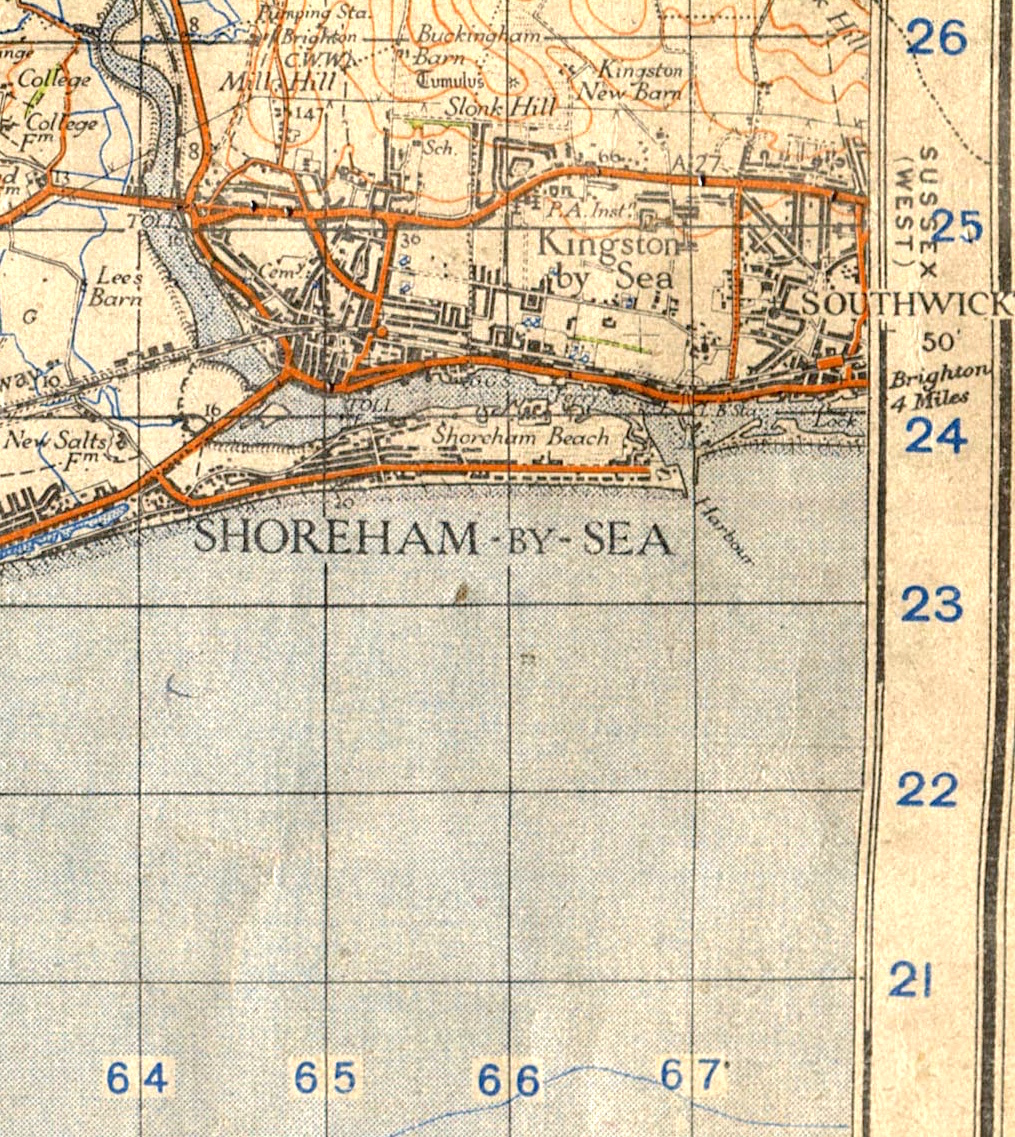
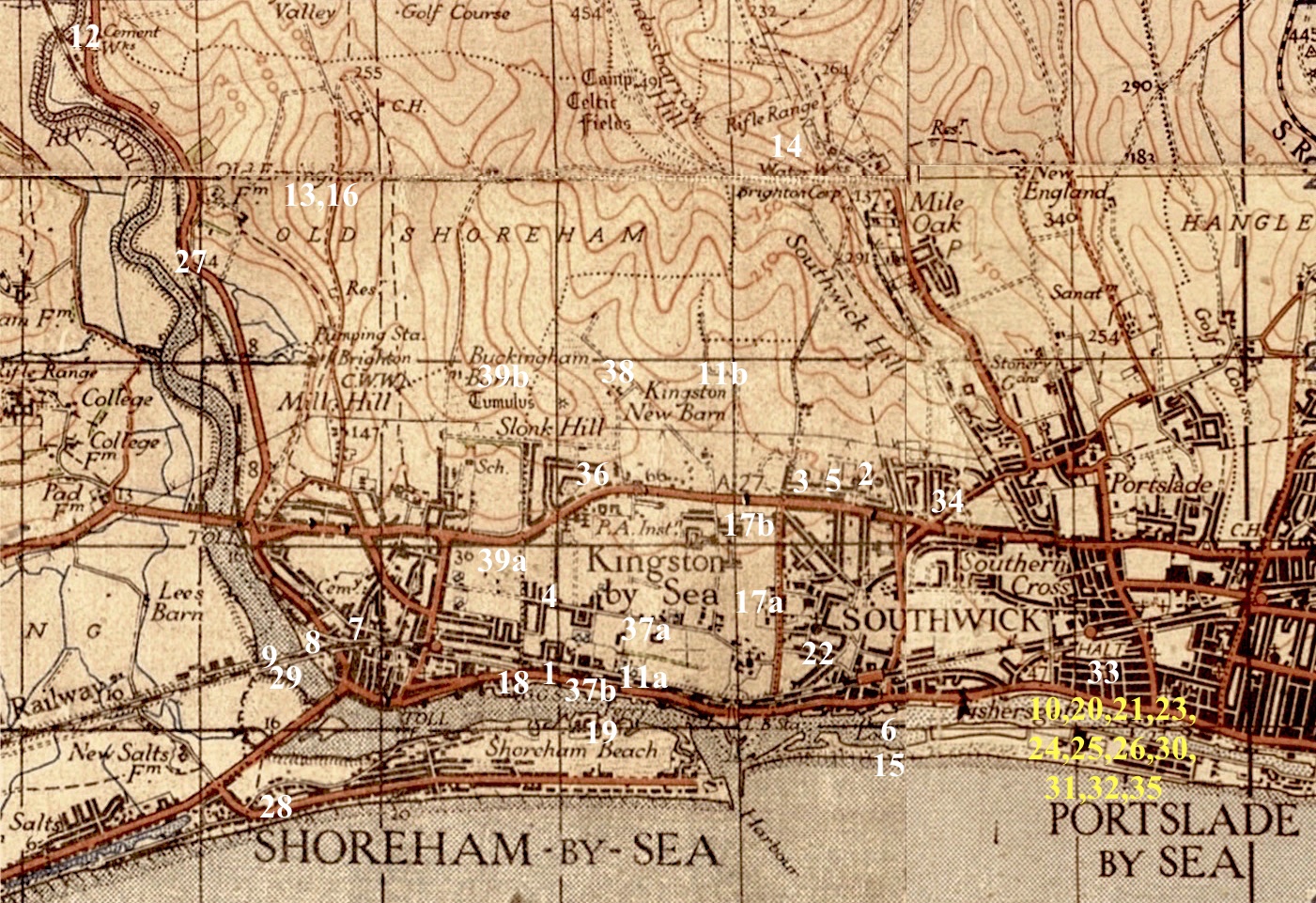
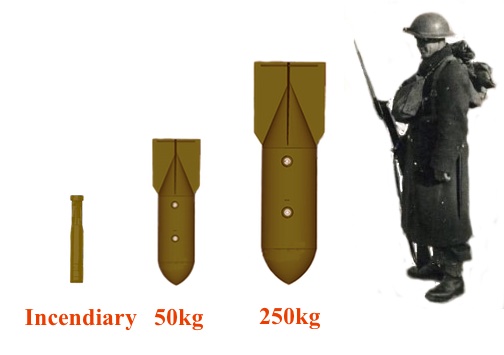
The average German bomber could carry up to four 250kg high explosive bombs, or ten 50kg high explosive (eighty per cent of those dropped were this size and were very effective at blast damage) or some few hundred of incendiaries. Sometimes all were dropped at once in sticks or singly and incendiaries in part loads so that missiles from the same aircraft could be some way apart.
1940
France, Belgium, Luxembourg and Holland are invaded by German troops; British troops retreat from Dunkirk; Shoreham Beach (Bungalow Town) is cleared of its buildings as fears of invasion grow; London suffers its heaviest attack of the war but the Battle of Britain ends with air superiority for Britain
The Minute Books do not start to show Shoreham or Southwick incidents until 14th September 1940 but we have a few scant details of some incidents prior to this (the impact points for these first few are approximate as no map references were included). The abbreviation HE refers to High Explosive (bombs) and IB to incendiaries: –
13th August
1. Seven high explosive bombs and one oil bomb dropped in the Lower Brighton Road (later to become Brighton Road) Four persons injured. (Shoreham Herald 6th October 1944).
22nd August
Twelve HE bombs were dropped from the Industrial School at Portslade to 2. Millcroft Avenue and 3. Downland Avenue, Southwick. No casualties. (Shoreham Herald)
28th August
4. Eight HE bombs fell southwards from Middle Road where residents actually saw three of the bombs fall from a German bomber and demolish a few houses there. Despite that there were no casualties. (Shoreham Herald)
14th September
Bombs fell again in 5. Downland Avenue and 6. four in the harbour behind Southwick Town Hall. These may be the first Shoreham/Southwick incidents recorded in the Minute Books that report incendiary bombs at 02.13 that day with one house on fire. There was an earlier report from Shoreham confirming two delayed action incendiary bombs there, perhaps the same incident but in both cases no map references were given as the necessary maps showing the relevant co-ordinates had not then been issued.
26th September
7. At 16.24 a stick of HE bombs was dropped around the railway viaduct, the first falling on houses in Buckingham Street where seven people were trapped in the demolished houses. One woman who lived in the Cottages was pinned under a slab of concrete after the raid and could hear the rescuers walking over the concrete but wasn’t found and rescued until a while later.
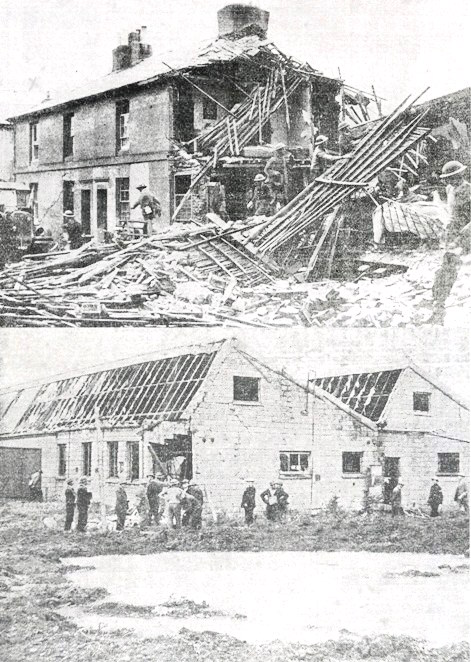
The report mentions ‘bombs’ but does not specify how many although we know from photographs and newspaper reports that there were at least two others, probably three:-
8. The second bomb fell between the Steyning line bridge and the viaduct. This was on the west side of the Old Shoreham Road where it exploded, narrowly missing the Imperial Laundry building but smashed most of its glass roof where eight of the girl workers were cut by the flying glass. There may well have been another unrecorded bomb during this strike at the eastern end of the railway bridge as one of the columns there was badly damaged and the strengthening bands that were fitted as a repair can still be seen.
9. A further bomb did not explode immediately but lodged into the riverbank under the west end of the railway bridge. This appears to have been a delayed action bomb as two and a half hours later it did explode causing damage to the bridge and preventing the train service for some time.
10. At 16.55 a direct hit on Portslade Gasworks was reported together with the words “outside this county” as this came under East Sussex. No further information was entered but, despite being apparently out of area, further Portslade incidents at the Electric and Gas Power Stations area were nevertheless later reported and are included.
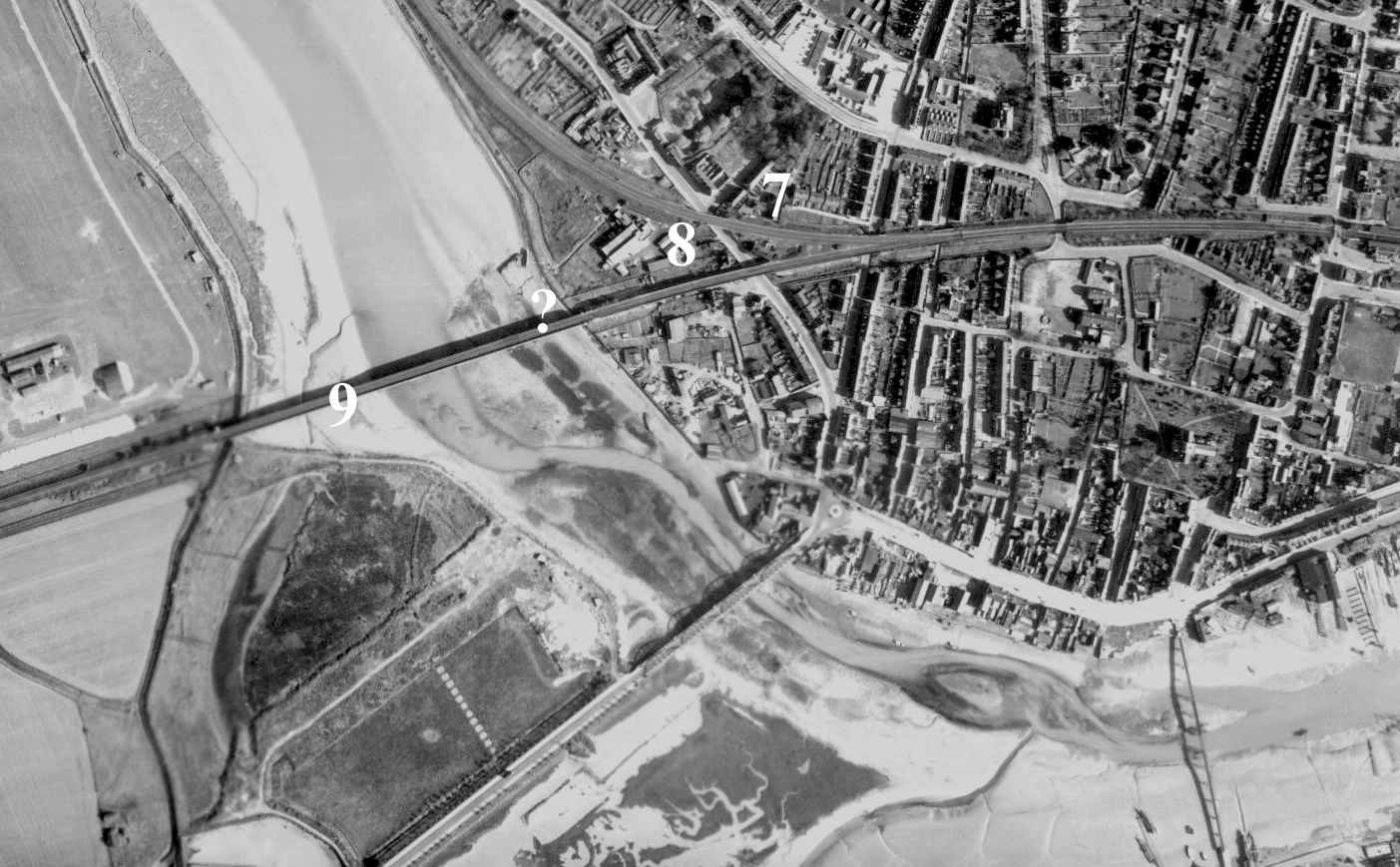
28th September
11a. At 22.26 just north of the Brighton Road at Kingston one light HE bomb and one unexploded bomb are recorded.
11b. Shortly after another two HE bombs, and again one unexploded, were reported four hundred yards north of the Hawkins Road flats (Hawkins Road, north of Kingston Broadway and north-west of Kingston Lane)
These were subsequently noted as being the same incident but it is unclear whether one bomb was dropped at Kingston and the other at Hawkins Road or if there were four bombs in total.
29th September
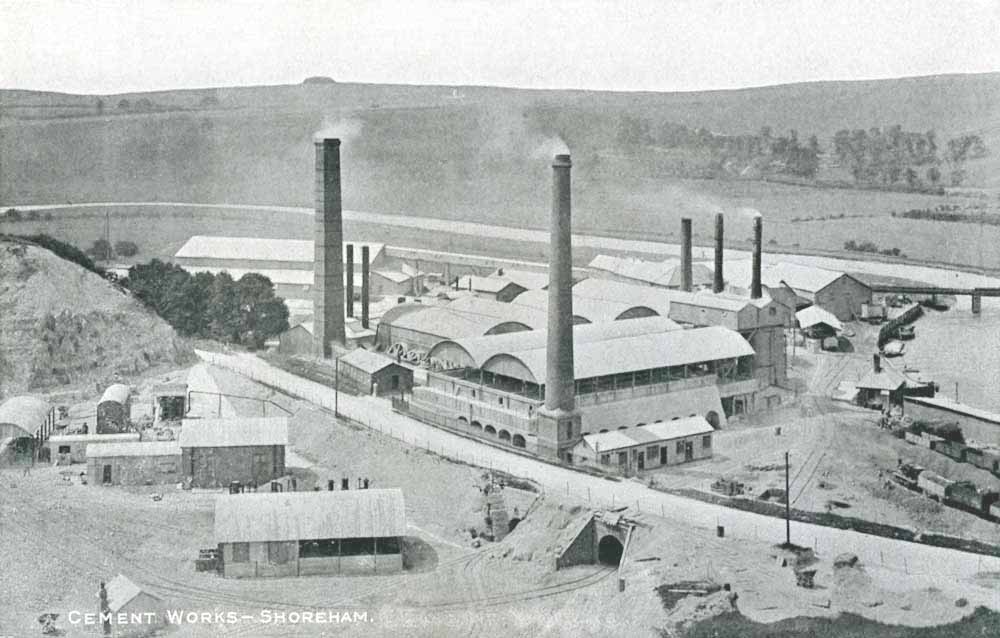
12. Report timed at 05.30 hours Beeding Cement Works received a concentrated attack of 16 HE bombs (stated to have been dropped at 02.55). Six of these fell on the Shoreham/Horsham branch railway line, two failed to detonate; three hit the factory itself of which one was unexploded; one fell in the factory grounds and failed to explode; one hit the Steyning Road and another five impacted on the river bank and adjacent fields.
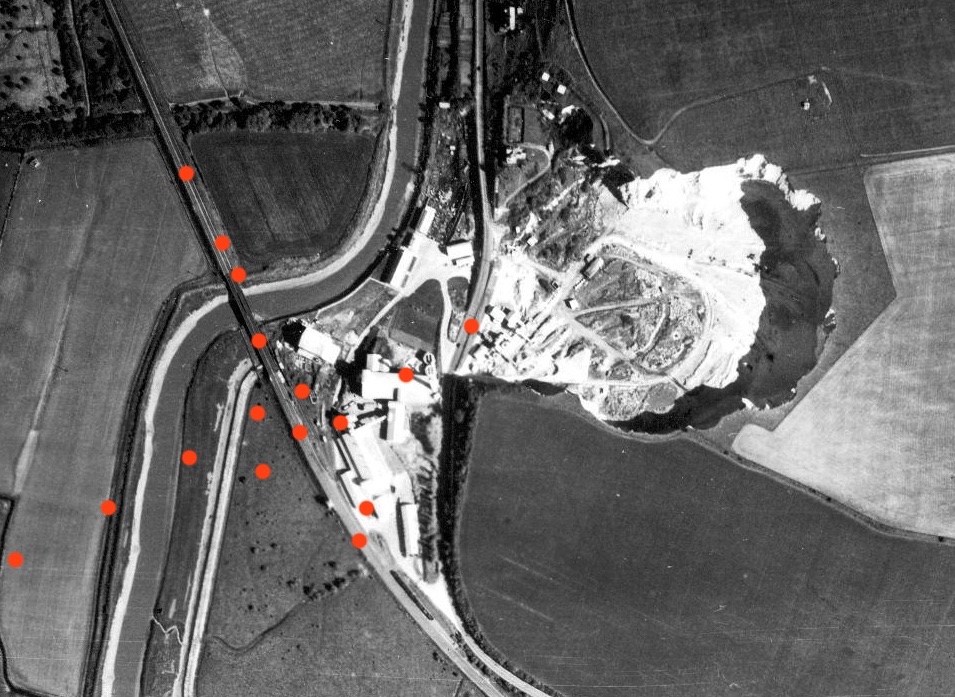
A member of the Shoreham Home Guard by the name of Bazen who also worked at the Cement Works witnessed the bombing of the railway line and realising that a goods train was due ran down the line waving a lamp and managed to stop it.
The bomb crater in the road and the danger from the unexploded bombs meant that traffic to Steyning had to be diverted via the road on the west side of the river. Both up and down lines of the railway track were damaged, goods trucks were derailed and the factory-loading shed was demolished. Electric cables were damaged and telephone wires brought down but otherwise there were no casualties. After a very short time the road/rail repairs were completed and unexploded bombs defused. The factory’s machinery was undamaged and maximum output capacity soon resumed.
13. At 10.26 that day the RAF reported an unexploded bomb near ‘the tower at the top of Mill Hill.’ This was the Fighter Command VHF direction finding Fixer Station that was attached to RAF Truleigh Hill and was situated just west of the Shoreham/Truleigh Hill Road above Old Erringham Farm.
RAF Command at Tangmere ordered the men to vacate the tower pending the bomb’s defusing.
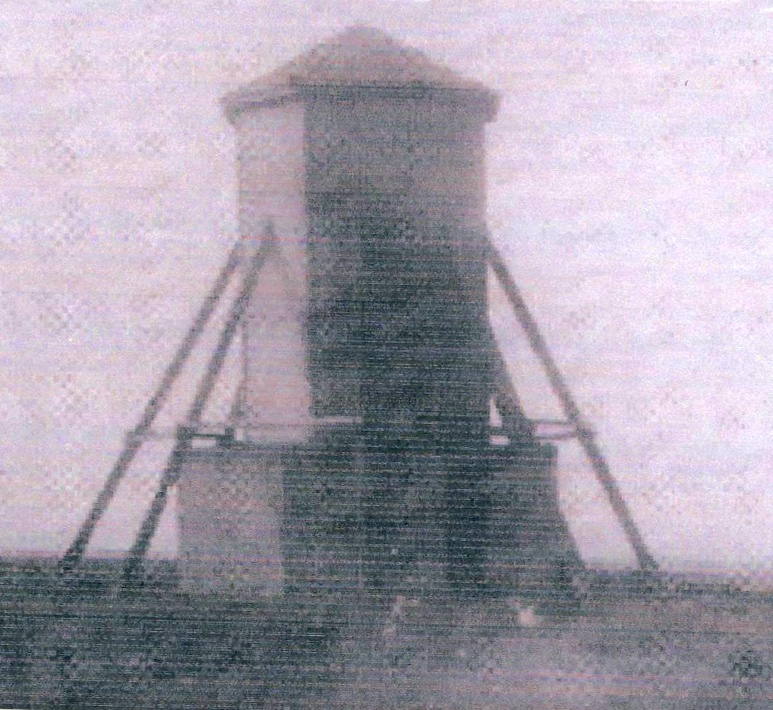
14. At 17.18 on the Downs near the water works at Mile Oak Farm 4 HE bomb craters were reported to have been discovered. The explosions had been heard earlier at 22.08 on 28th September and as the bombs had been dropped in a military area (there was a rifle range nearby) the military at Steyning dealt with the matter.
1st October
15. Four HE’s exploded on the beach about 11.30am at back of the Southwick Town Hall. No casualties or damage apart from broken windows.
At 18.25 one girl was taken ill at White Box Factory, Kings Drive, Shoreham and a man died from shock at 48 Victoria Road following air battle that took place at 18.20 hours.
7th October
16. 20.03 A number of IB’s at Truleigh Hill were reported by Police but this was followed by a later report giving the map co-ordinates showing that these were in fact ‘by the RAF Detector Station’ (i.e., the Fixer Station mentioned earlier). Two HE bombs had also been reported but were later found to have fallen on the west side of the river and are therefore not included in Shoreham’s incidents.
(Surprisingly, the main radar station at Truleigh Hill does not appear to have attracted much attention from enemy attacks. There was just one recorded instance when bombs fell around Truleigh Manor Farm on the Edburton Road below the hill that may perhaps have been intended for the station.)
8th October
17a. A wartime newspaper report stated twenty-four bombs were dropped in this raid but the Minute Books only record five. At 19.15 five enemy aircraft were reported as having dropped four HE bombs in Kingston Lane and machine-gunned the road. This was thought to be an attack on the railway bridge there and although the bombs missed their mark buildings were badly damaged and Tile Cottage, Rectory Gardens was totally demolished killing resident Mrs Alice Ford aged 35. Elsewhere in the area six others were injured, one seriously.
17b. A delayed action bomb, perhaps from the same incident, was also discovered and disarmed by the Bomb Disposal officers 50 yards west of Kingston Lane in Ayling’s Market Garden. There was another bomb reported ten yards away although this was later disputed.
20th October
18a. 10.55 The heaviest death toll for the area occurred when four HE bombs were dropped onto the wharf of the Shoreham Shipping Coal Co south of the Brighton Road opposite today’s B&Q superstore. Eleven year old Chris Martin had just left Whites timber yard with a cart loaded with six penn’orth of kindling and was just up by the allotments when he saw a lone Dornier, coming from the northwest quite low and watched the bombs as they dropped.
Five persons were killed including 17 year old Home Guard George Earthey, Arthur Laker a fire fighter and John Hoad all from Shoreham. Two other bombs fell in the river near the Chemical Works.
18b. During the same raid twenty-four houses were damaged in nearby Corbyn Crescent and Dolphin Road. The Brighton Road was blocked and traffic diverted via Middle Road.
4th November
19. 04.58 Despite ten HE bombs being dropped near the Forbes Abbott & Lennard Chemical Works there were no casualties and only slight damage to the Works’ store plus a fractured sewer. No stoppage in production.
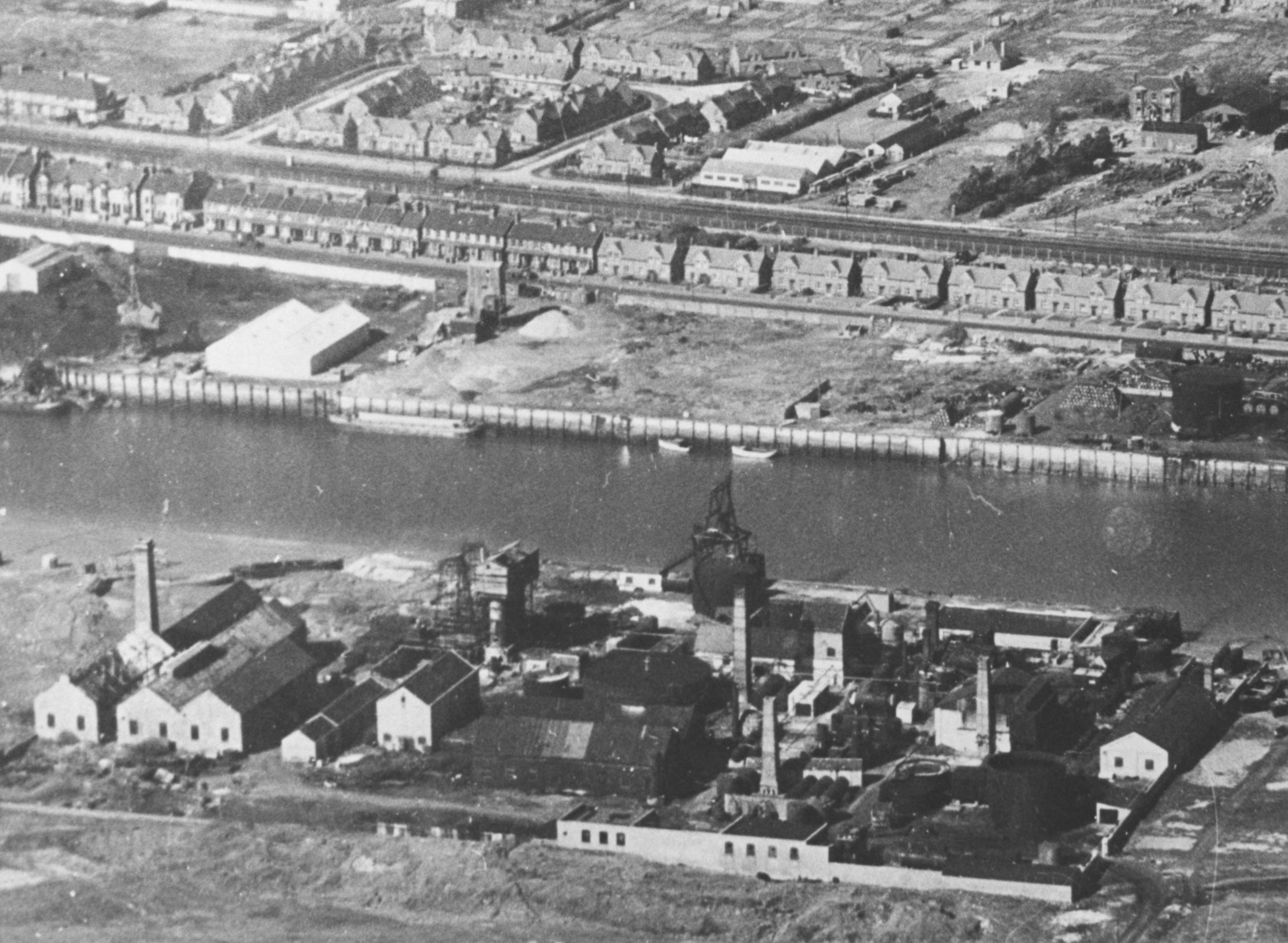
9th November
20. 18.45 The oil tanker ‘Shell Brit’ that was docked in the canal at the petrol depot near the power station received a direct hit killing three and injuring six others. Part of the bomb was subsequently discovered and thought to be a new type of incendiary and high explosive combined.
13th November
Unsurprisingly, reports before and after this next raid reveal that the electricity and gas power stations on the Portslade/Southwick border received a lot of attention from German raiders with no less than eleven bombing incidents during 1940 – 1944.
21. 17.35 Eight HE bombs dropped in and around the electric and gas power stations. Two Canadians (soldiers?) were slightly injured with relatively minimal material damage caused by six of the missiles – two on the gas station’s oxide pump (one of which did not detonate) and slight damage to a shed; one on a coal bunker; one on a steel dump; one, a direct hit on the contractor’s crane completely demolishing it and another between the crane and a coal bunker. A subsequent report from Engineer confirmed that the output of electricity and gas from the Power Stations was not affected at all.
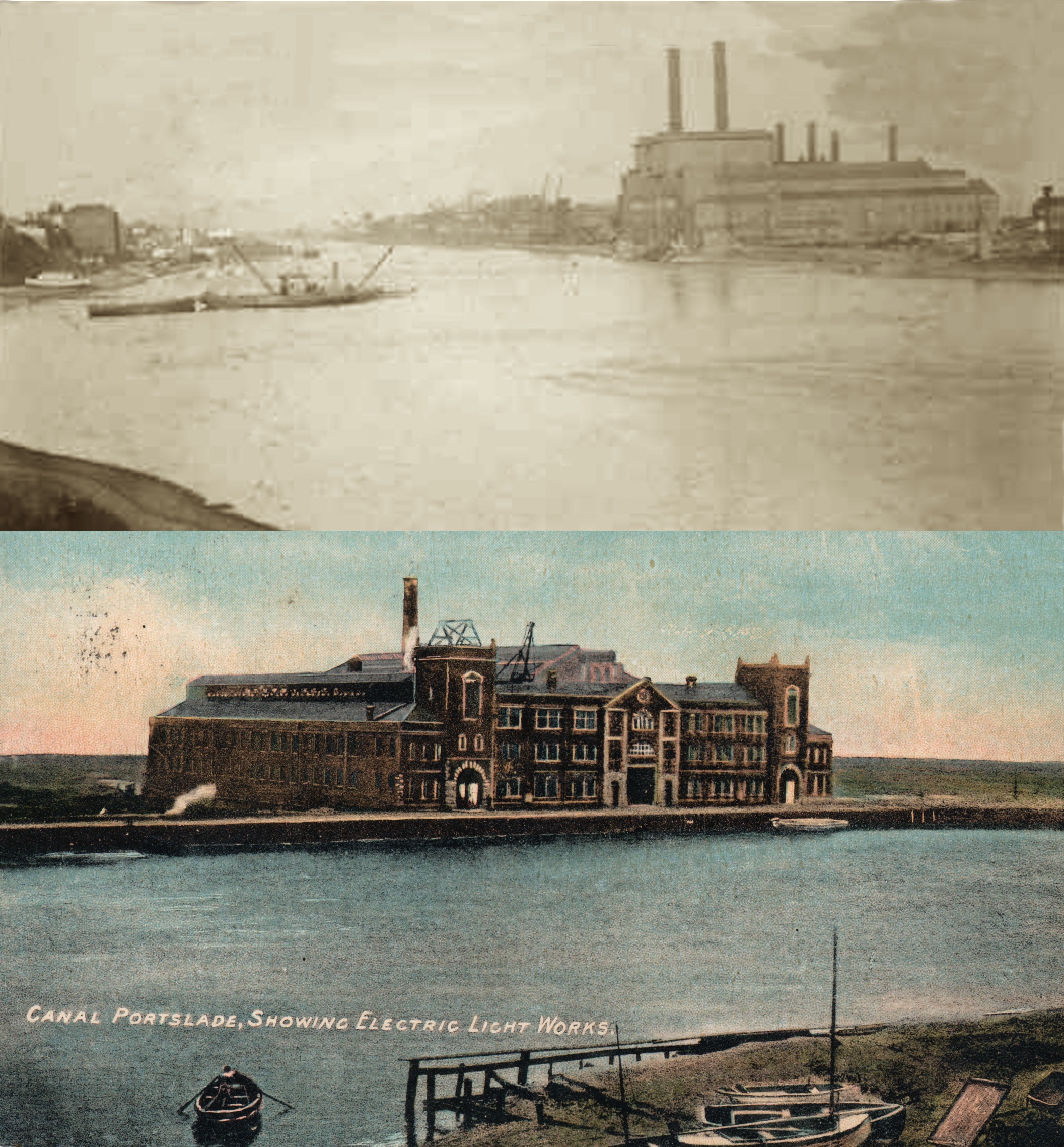
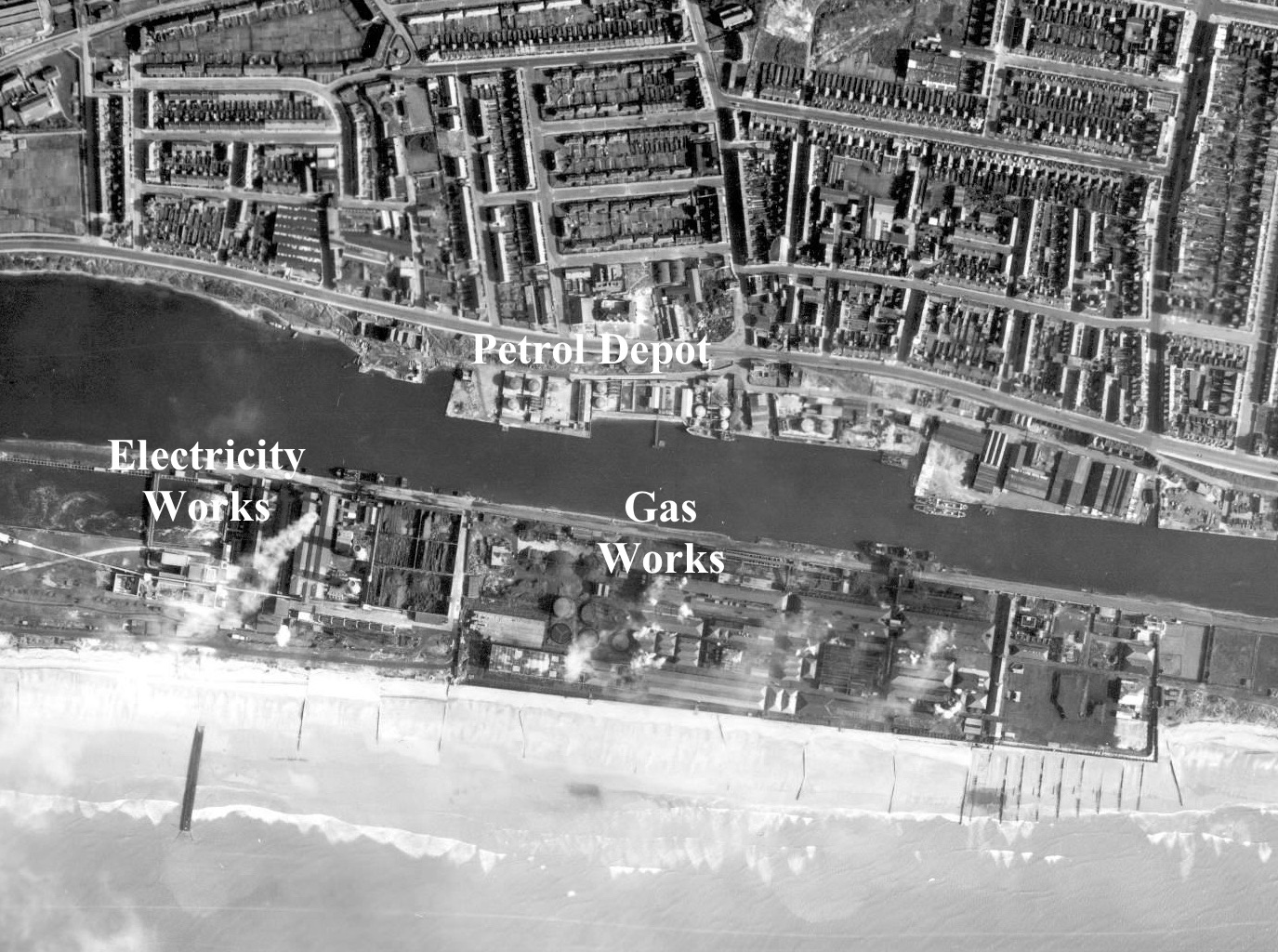
1941
Leading Nazi Rudolf Hess parachutes into Scotland; the German battleship Bismark is sunk; clothes rationing begins; the RAF reveals radar is being used to locate enemy bombers; HMS Ark Royal is sunk; the United States declares war on Japan; Hong Kong surrenders to the Japanese
Two incidents around this time not specifically related to Shoreham provide an example of some of the other matters recorded in Action Officers Minute Books that were generally notified to Report Centres in the area:-
30th January
This notification indicates where artillery guns were sited:-
“Message from Regional Control – Firing practice will take place tomorrow from Upper Beeding 09.30 out to sea opposite South Lancing and from Walberton at 11.30 out to sea off Littlehampton. The target is to be about 2500 yards from the shore.”
17th February
… and this reveals fears of gas attacks:-
“Message from Regional Control re Gas Alerts that meteorological conditions on South Coast were tonight favourable to cloud gas attack and suggesting that Sub Controllers concerned should quietly be informed of this.”
20th February
22. A stick of bombs fell on Southwick at 11.50 although strangely the Minute Book contains no entry for it but does go on to report that two of the bombs failed to explode. One of these hit a house in Park Lane and a sentry or policeman was put on guard to keep people away from the possible danger. The next day, perhaps due to a call of nature, the sentry vacated the scene temporarily which was just as well for him as the bomb chose that moment to detonate and completely destroyed the house and its neighbour.
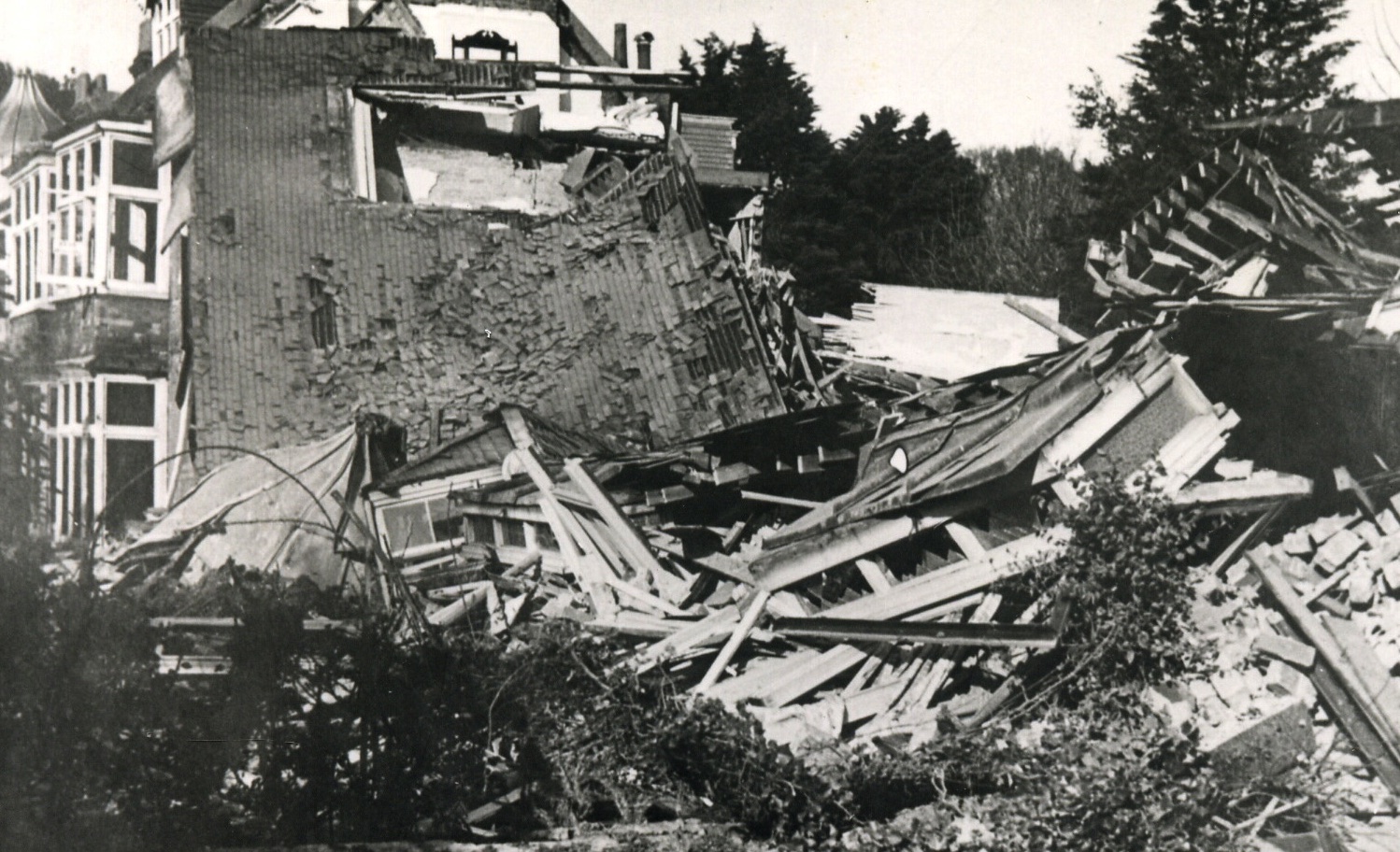
The second unexploded bomb had completely disappeared into the earth below St. Michael’s church tower so badly damaging the latter that it was necessary to carefully dismantle it over a period of time. It wasn’t until the 1st January 1943 that it was possible to defuse the bomb – the tower was rebuilt after the war.
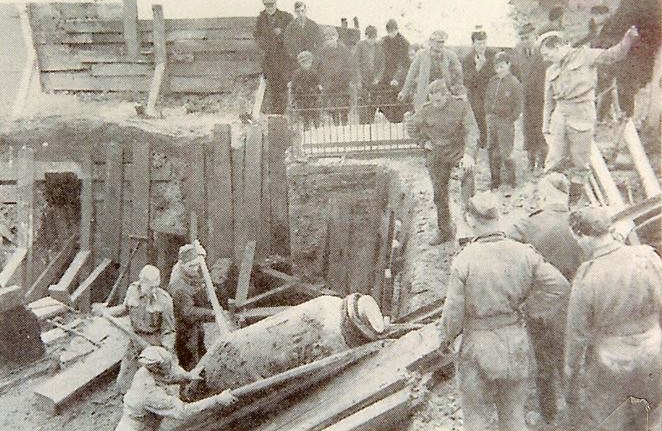
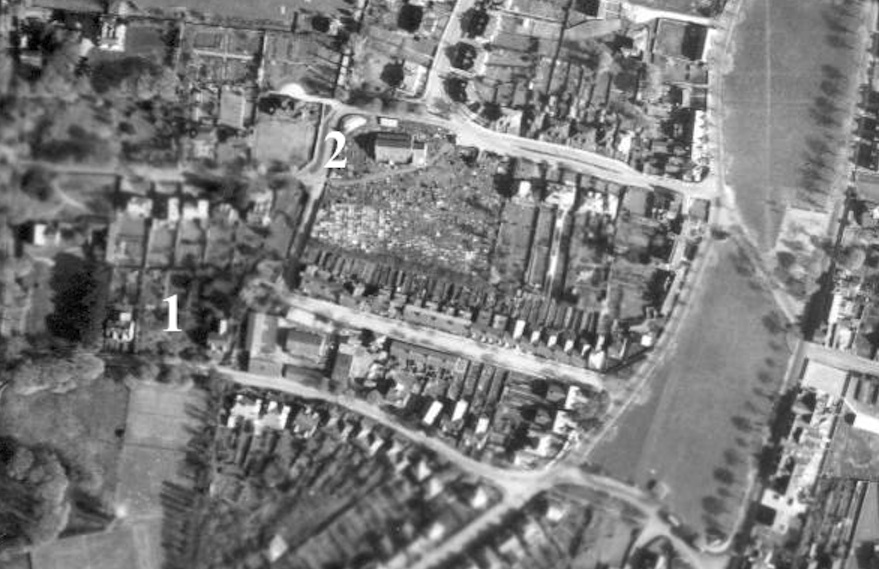
6th March
23. HE bomb fell in Gas Works yard but there were no casualties or any damage.
24th March
24. 13.00 Two HE bombs fell in the vicinity of the Gas Works
25th March
25. 10.23 A sole enemy raider dropped four HE bombs on shipping in harbor but missed the ships as two bombs fell in the canal and two landed in coke dump.
26th March
26. 19.25 The power stations appear to have been attacked yet again when two HE and one oil bomb fell harmlessly into the canal. Two incendiary bombs perhaps from the same raider landed in Southwick but failed to explode. A Portslade man working in Southwick was slightly injured and property was damaged by machine gunning.
11th April
27. 02.50 One HE bomb detonated on the Steyning Road near Old Erringham Farm bringing down telephone wires. It caused a crater that was too big for the local men to deal with and had to be referred to the Divisional Surveyor to provide a gang of enough workmen.
Later that day an unexploded bomb was reported close by a little further north and was likely have been dropped during the same incident
16th April
Another situation of passing interest is an entry recorded at Shoreham
at 10.55 of a notification from the Police that a Barrage Balloon was adrift and was now NW of Chanctonbury Ring. The RAF at Tangmere were notified and the matter was dealt with by them. No subsequent mention was made of the incident but it would have been interesting to know what action was taken to retrieve it.
7th May
28. Two HE bombs were dropped on the West Beach of Bungalow Town just east of the Church of the Good Shepherd. The Beach had already been cleared of buildings as a precaution against invasion and was under military control. There was no damage and no casualties.
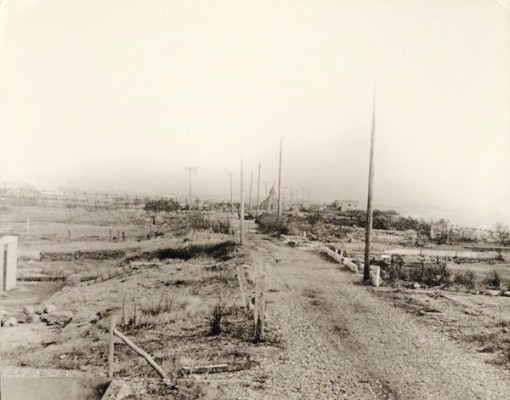
9th May
29. 03.35 Two HE bombs, part of a raid on the airport, one of which fell on the railway bridge causing extensive damage. R.Bowles worked in Shoreham at the time and remembers flames coming from the bridge’s fractured gas pipe and railway lines with sleepers still attached bending down into the water. The second bomb was later found to have exploded beneath the bridge. The official reports also confirm the gas main pipe alongside the bridge was fractured and the leaking gas was on fire. The bridge was not sufficiently repaired to enable the continuation of traffic until the 1st June.
17th May
This next incident did not take place at Shoreham nor Southwick but six miles away out at sea. It was nevertheless sufficiently close enough to be recorded as a local incident.
16.30 Four enemy planes attacked three ships bound for Shoreham -– ‘NSS Ala’; ‘SS Botney’ and ‘SS Arthur Wright.’ The Norwegian ship ‘Ala’ was hit amidships and the steward’s wife Rebecka Hansen was killed. One of the attacking aircraft appeared to take a hit from the Arthur Wright’s 12-pounder gun, which did not pull out of its dive and plunged into the sea – the ‘kill’ was later officially credited to the gunner. The Arthur Wright, a Brighton Corporation-owned Shoreham collier carrying fuel for the power station took bomb damage from a near miss, the ship’s propeller shaft was distorted, internal fittings were destroyed, holes were punched in the metal decking by cannon fire and the ship’s gun was wrecked (but not, apparently, causing any injury to the gunner). The Ala was towed to the shore and beached at Shoreham; Arthur Wright managed to make it into the harbour under its own steam accompanied by the undamaged Botney.
Rebecka Hansen was buried at Shoreham’s municipal cemetery and although the Ala was repaired and refloated it was later sunk by a mine on the subsequent voyage from Shoreham.
(NB Brighton Corporation’s other collier the ‘Henry Moon’ and the two vessels ‘Pulborough’ and ‘Portslade’ that supplied the gasworks had already been sunk the year before in convoys at sea elsewhere.)
23rd June
21.50 A British Spitfire fighter aircraft having sustained damage in a dogfight came down in the sea just off the beach south of the power stations and the pilot, Sergeant Pilot Beedham, was swept eastwards by the currents but eventually swam ashore at King Alfred Naval Station.
12th July
11.10 A large explosion took place on the west side of the entrance to the harbour that damaged both piers, blocked the channel for the shipping and broke glass in 22 houses in the Brighton Road.
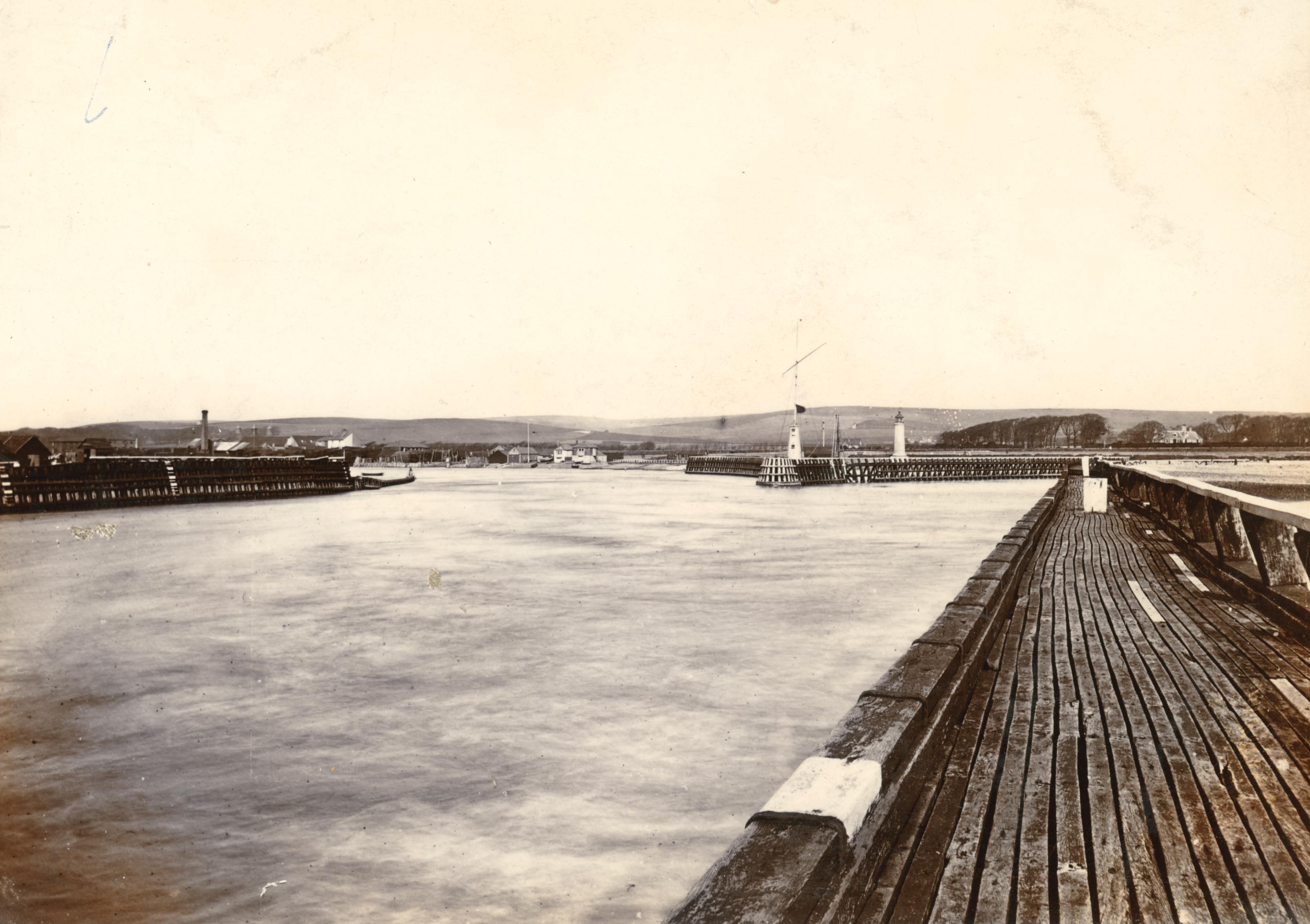
Large holes had been bored out in which two depth charges were placed as part of the invasion defences. These were electrically wired to one of the nearby Naval houses for detonation in the case of an attack but were set off accidentally. Mr R. Bowles worked for J.T.Mackley who were tasked with repairing the damage. Mr Bowles stated that this all occurred during a mock (practice) attack involving Canadian troops but no training exercise is recorded for that time. One of the company directors(?) Frank Mackley remembered the incident but thought it to be during the following year.
Exercises involving mock invasion attacks and defence were held throughout West Sussex and the local exercises recorded at Shoreham and Southwick were in 1942 on 14th May and another on the 4th/5th July that year (as included later) but neither mentions another harbour explosion.
The Naval Authorities subsequently held a Court of Enquiry.
(No further action is recorded in the Minute Books for either Shoreham or Southwick between July 1941 and April 1942)
1942
Soap is rationed; Singapore surrenders to the Japanese; the island of Malta is awarded the George Cross for heroism during the German and Italian bombardments; the Dieppe Raid is carried out with heavy casualties for the British; the Germans bomb Canterbury as a reprisal for the bombing of Cologne; British troops in North Africa have Rommel’s Army in full retreat
24th April
30. 16.45 Two HE bombs hit the Electric Light Works, one at the rear of the transformer house and another near the Gas Works. The windows and roof of the former were damaged with two slight casualties.
12th May
31. 17.48 Three HE bombs again hit the Electricity Works including a direct hit on the boiler tower. One person was killed and ten injured. There was blast damage to the Works and 32 nearby buildings, mostly to windows.
14th May
The Shoreham Herald of 22nd May 1942 reported ‘All branches of the Civil Defence, fire services and Home Guard were thoroughly tested in a mock invasion at Shoreham and Southwick last weekend.’ The Minute Books show two previous entries on the 14th May, one at 20.22 hours that reads ‘Shoreham & Southwick – first message of exercise’ followed by another at 21.55 reading ‘exercise concluded.’
The 14th May that year was a Thursday, not a weekend and the exercise only lasted one and a half hours – hardly enough time for defences to be thoroughly tested! J.T. Mackley employee Mr. R. Bowles, recalled one such exercise reportedly involving French Canadian troops acting as the invasion force but things went wrong when some were killed by land mines as they ran up the beach. If this is correct and was the same incident could this be why the exercise on this day was so short and perhaps called off because of the fatalities and hushed up because of the possible effect on morale?
Another exercise followed two months later spread over an entire weekend that was considerably more involved (see 4th/5th July).
31st May
A general message to all Sub Controllers this day:- “RAF raid on Cologne last night was successful and heavy. Reprisals must be expected in the near future – All services should be on the alert particularly during this moon.” (e.g., bright, full moon ideal for bombing) This was the 1,000 bomber raid by the RAF.
16th June
32. 06.08 Two HE bombs were dropped, one fell harmlessly in the canal, the other on the office, fitting shop and blacksmiths shop the latter causing extensive damage to the front of the Electricity Power Station building. Slight blast damage to the wharf on the north side from the bomb in the canal. One slight casualty, all telephone lines out of order but industrial output unaffected.
4th/5th July
On this weekend an extensive exercise, code-named Exercise Actex (Blitzmerg) that simulated defensive action during a heavy bombing raid took place in Shoreham and Southwick and from the entries recorded appears to have been carried out in real time.
The exercise began with reports of bombs on Norfolk Bridge, the railway station and heavy bombing generally in the district. There were echoes of the actual bombing of 26th September 1940 when the exercise used Buckingham Street and the Imperial Laundry as being ‘hit’ by bombs but this time with the Old Shoreham Bridge ‘hit’ by incendiary bombs and on fire as well. Sunshine Avenue (a seemingly fictitious avenue), Southwick had been hit with IB’s and an HE bomb on the Town Hall with Albion Street blocked. The School Cottage in Ham Road was on fire with six people trapped. An HE bomb in Little High Street with 6 casualties. The railway bridge over the river had collapsed. The Cleveland Petrol Depot at Southwick was on fire. High explosive and incendiary bombs had also fallen on the Old Shoreham Road, Buckingham Road and the railway line was blocked east of the station.
This all took place shortly before another exercise, Acorn Exercise at Bognor, continued the action where sham fifth columnists were infiltrating the area. All in all together with the Shoreham/Southwick exercise it must have simulated a considerably realistic mock invasion.
4th August
33. 10.33 Several HE bombs were dropped on the St. Richards Road and Mill Road area in Fishersgate. Two houses were hit, one of them being number 16 tragically killing the residents there 23 year old Joyce Gatrell and her 21 month old son. There were a total of three fatalities from that raid with 28 being treated for injuries at the First Aid Post and 4 seriously injured taken to hospital. The local military assisted the 60 men, largely civilian volunteers that were included in the rescue parties.
9th August
34. Around 23.34 twenty IB’s were dropped on the lower part of Mile Oak Road area of Southwick. The area of impact included East Bank, 10 Greenways and the Mile Oak Road itself. In total 12 to 15 houses were damaged, none seriously. Rescue, First Aid parties and an ambulance were dispatched but there were no casualties. Two IB’s did not ignite.
17th August
17.23 Shoreham reported four barges proceeding at sea in a southerly direction. Two bombs were dropped on them by enemy aircraft whereupon a smoke screen was operated. Brighton later reported that one of these barges had been sunk.
24th August
35. 18.00 HE bombs fell on the east side of the Electricity Works. The precipitation plant was damaged and although the plant’s industrial output was unaffected the export output to the grid was temporarily interrupted. There were 6 casualties of which 3 were sent to hospital. The damage to the precipitation plant was superficial caused by blast and was easily repaired.
Ground Defences
Anti-Aircraft and ground defence fire in response to passing (as opposed to attacking) enemy aircraft occurred from time to time between 1940 and late 1944 for Shoreham and Southwick collectively but are not of sufficient importance to include separately.
1943
The RAF bombs Berlin and breaches dams in the Ruhr using bouncing bombs; Allied forces invade Italy; the German battleship Tirpitz is destroyed by the RAF
30th January
There are occasional instances of sea mines washed up on the beach and exploding without damage or injury and most are not of sufficient interest to include in this work. The one on this particular day though caused more damage than usual and demonstrates the powerful blast effect of those mines. It detonated at 15.30 south of the Electric Light Works and although there was no significant damage the impact from the blast was sufficient to have pulled out two steel doors, steel rods were bent plus roof and windows broken. The blast also went on to damage 104 nearby houses (presumably across the canal), chiefly to roof tiles and glass. There were no casualties and output from the Works was unaffected.
9th June
At 22.20 a land mine exploded on the beach at Southwick killing one person. No further details were given and no map references to locate the spot.
26th August
19.38 An ‘English Fighter Bomber’ is reported to have crashed at the top of Kingston Lane. There were no casualties but no further details are given.
18th November
18.34 Another plane was reported to have crashed on the Downs at Shoreham north of Kingston New Barn. An explosion was heard and five objects were seen to be burning there. A subsequent investigation makes no mention of an aircraft but found what appears to be two pieces of British ordnance. They are described as follows:-
1. A light metal hexagonal shaped tube eight and a half inches long and one and a half inches across marked on bottom 6 NA No 11 – 1943 Mark 4 – a burnt out tube in centre.
2. A conical shaped piece of metal coloured brick red marked No 407 BCL 3-43. The burning material contained phosphorous.
1944
The Allies invade Europe (D-Day); V1 flying bombs hit London followed later in the year by V2 rockets killing thousands; Paris is liberated; the German battleship Tirpitz is destroyed by the RAF
24th February
36. 21.45 A stick of incendiary bombs fell on the north of the Upper Shoreham Road opposite Southlands Hospital. Three of the roads they are shown to have landed in were Greenways Crescent, Garden Close where four houses in the latter were gutted by fire and, a little further away, Buci Crescent. Cadet Chris Martin was on his way home from attending Air Training Corps at the time and saw the incendiary bombs land across the hospital, Garden Close and the eastern end of Greenways. ‘We kicked burning bombs off the main road into the gutters.’
There were no casualties but eight persons were made homeless as a result and had to be rehoused for the night. Two long-standing Shoreham residents remember the incident well:-
Emily Hudson had moved with her husband to New Barn Road opposite Southlands Hospital where she worked near the Golf Club house. There were only six or so bungalows there then which were virtually in the countryside. One of the incendiaries during this raid brought her ceiling down but luckily burned itself out without destroying the bungalow.
Young Richard (Dick) Steers lived further down at Greenways Crescent. He was working for Braybons at the time and was particularly proud of the roofs that he helped construct on the parade of shops that were being built opposite the hospital just above his home. As he left his house he was met with the sight of a line of unexploded incendiary bombs on the green in front of him, sticking out of the earth with their fins showing like a row of vegetables on an allotment. This was a continuation of the stick of bombs that had hit Emily Hudson’s home and, to Dick’s dismay, had also straddled the shops to burn and demolish part of the roof he had built.
2nd March
37a. 02.43 Incendiary bombs fell onto open ground near Middle Road, Shoreham.
37b. During the same raid incendiaries were also dropped at Kingston Wharf that set light to the warehouse and damaged Naval property (not specified). Police later retrieved 11 unexploded incendiary bombs. There were no casualties.
28th May
38. 23.40 One HE bomb fell on the buildings around Kingston New Barn. One house was demolished with damage to water and telephone services. There was one minor casualty.
6th June
In the left hand margin of the minute book amongst the trivia recorded that day there is an entry in large capitals saying nothing more than
‘D-DAY.’
For reasons of security and the fact that matters in the Minute Books were dealt with and recorded by both male and female civilians it is clear that whenever an incident involved the military (e.g., the RAF at the Airport and Truleigh Hill; the Beach area controlled by the Army etc.,) nothing was recorded other than ‘being dealt with by the military’ with the result none of the masses of landing craft and equipment moored in the harbour received the slightest mention in the Minute Books – apart from that jubilant notation!
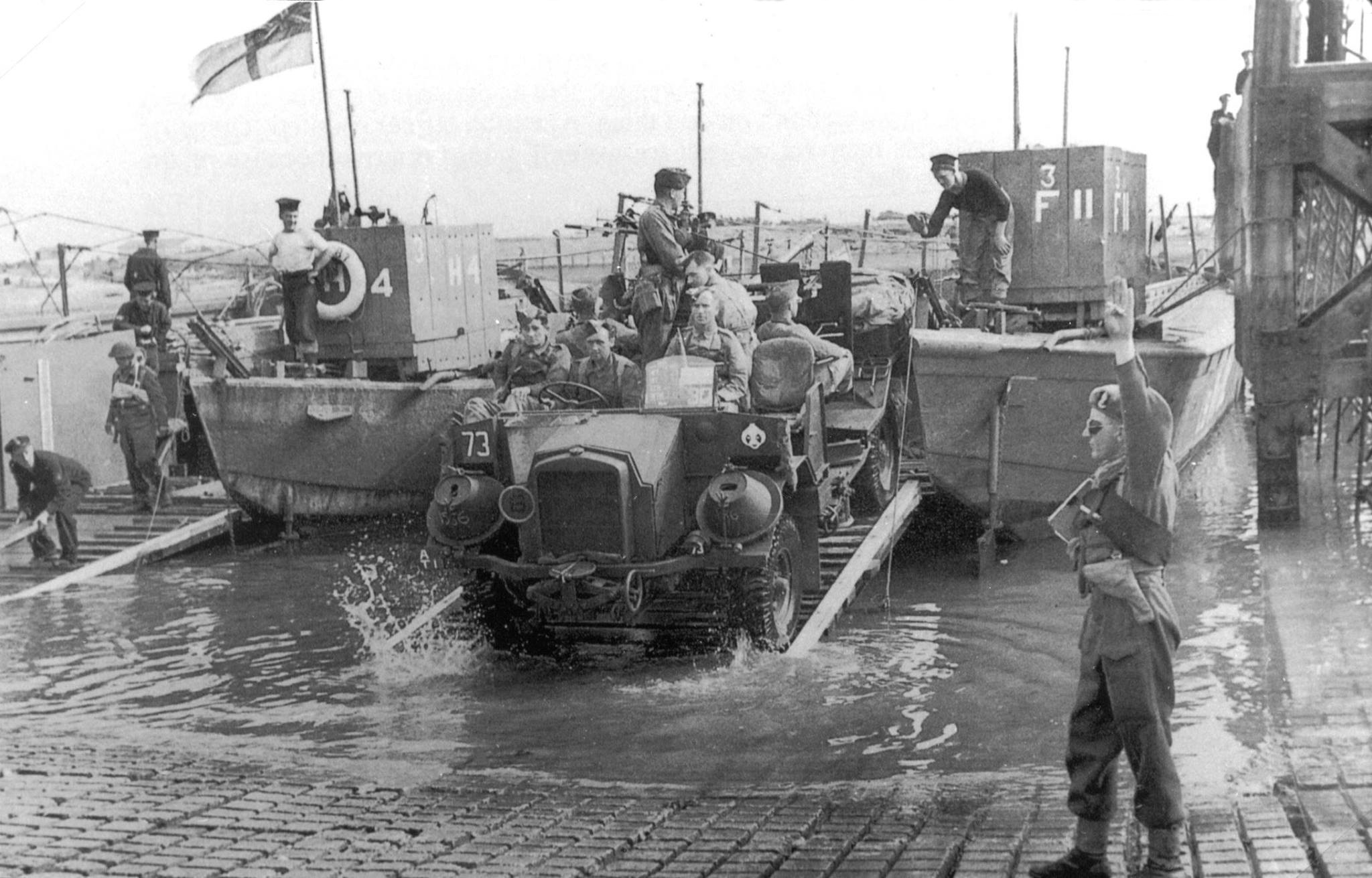
18th June
23.07 An enemy aircraft was shot down in the sea by Anti-Aircraft fire south of Shoreham Harbour. No further details.
5th November
19.36 A V1 flying bomb or ‘doodlebug’ impacted in the allotments just behind the houses on the top/west side of Eastern Avenue 39a. The map co-ordinates recorded this as 656/259 but this reading places the strike just east of Buckingham Barn 39b, well north of Buckingham Park. This is without much doubt a mistake and more accurately should have read 656/249 as witnesses at the time all confirm the impact point was in the allotments.
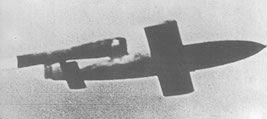
The blast damage was significant and five hundred houses were damaged, fourteen seriously. The maximum range of blast of a V1 was considerable – up to 600 yards in all directions but if the bomb had fallen at the recorded co-ordinates there were not enough houses in that range to have accounted for the 500 damaged. Despite the damage there were only two slight casualties treated at First Aid Post and sent home, 2 more serious were treated at Southlands Hospital and one detained.
Local knowledge of the event unanimously favours the allotment as the impact site. John Lyne recalls:- “a Doodlebug exploded by the Green Jacket on the allotments in Eastern Avenue. It was early evening on the 5th of November when we heard a staccato roar gradually getting louder, knowing what it was and not having enough time to get to the shelter we all dived under the table as it got closer, then seemingly overhead the engines cut out and after a few seconds a very large explosion that burst-in our French doors against the curtains, the taped glass was intact but the door latch had sheared off. There was a fair bit of damage to windows in Eastern Avenue. Nearby, neighbours were in their hall when the front door was blown up the stairs by the doodlebug’s blast and they spent the next couple of days picking glass out of the banisters with tweezers.”
Brian Bazen, a resident of Eastern Avenue, and Chris Martin also confirmed the doodlebug had landed behind the houses at the top of the Avenue on Les Scott’s allotment and had seen the crater there. The shock wave was also felt as far away as the Coliseum cinema down by the Brighton Road where one film-goer was thrown out of her seat.
There wasn’t much happening in our area after that and on 24th December someone entered ‘A Merry Christmas to All from Shift No.3’ As the war in Europe progressed and the danger of attacks on Britain receded it eventually became unnecessary for the Report Centres and Minute Books to be continued. They have nevertheless provided a valuable record of our two towns in wartime and the last entry at 23.59 on 1st May 1945 provides a jubilant and proud final flourish:-
‘Finis Coronat Opus’
(i.e., ‘the end (anticipated victory) crowns the work’)
Roger Bateman
Shoreham
November 2015
Acknowledgements:-
West Sussex Action Officer’s Minute Books – these are held at the County Record Office in Chichester and contain reports of all incidents reported to County Hall.
WW2 Maps with Coordinates held at County Record Office in Chichester
Shoreham Herald report of wartime bombs on Shoreham and Southwick 6th October 1944
Evening Argus article on Shoreham’s wartime mock invasion and explosion at the Harbour mouth 21st June 1991
‘Shoreham’s Radar Station: The Story of RAF Truleigh Hill’ by Roy Taylor
‘Southwick at War 1939-45’ by Nigel Divers
‘Shoreham’s War’ by Roger Bateman
‘The SS Arthur Wright – A Shoreham Collier’ by Roger Bateman
‘Sussex Air Photo Catalogue’ University of Sussex for 1940’s aerial photos
With thanks for their reminiscences and/or help with information to Paul Osborne, John Lyne, Gerald White, Cynthia Bacon, Roy Taylor, Chris Martin, Neil De Ville and, for photos, to the Marlipins Museum (Sussex Archaeological Society), Ted Heasman, Southwick Historian and private collections.


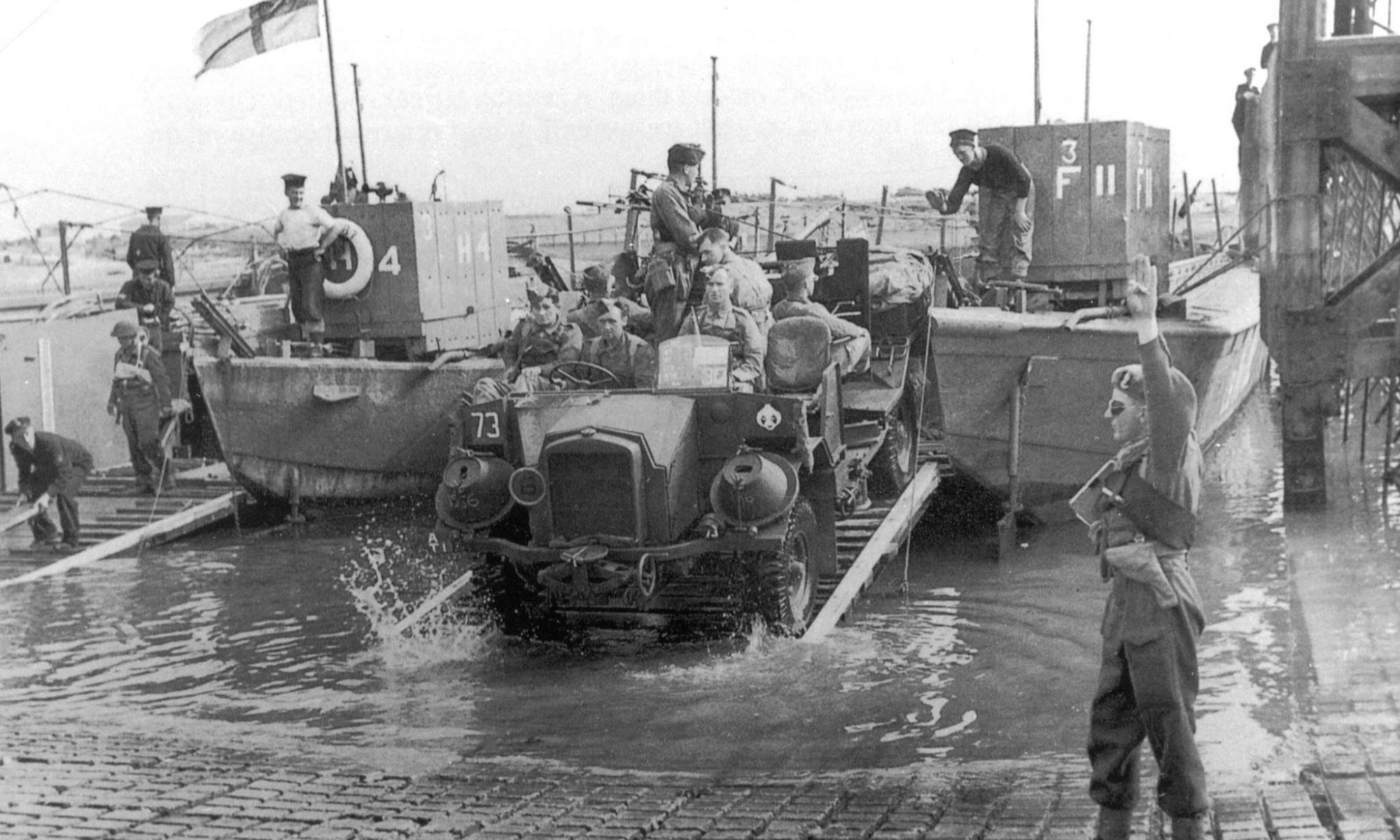
This article and the personal accounts are really interesting thank you. We live at 138 Eastern avenue, from the accounts our house is directly opposite where the doodlebug exploded in 1944. We have a strange old repair to a patch of roof tiles at the front, I’m wondering whether this could have been a result of damage in this explosion? If anyone knows I would be really interested to hear about what the road looked like in those days which houses were damaged by the bomb.
Thanks for your comments Gail and interesting to see that your house was close to the doodlebug impact point. I don’t think there is much doubt that it was damaged by the blast as must have been many of the houses in Eastern Avenue and surrounding area. The only person we knew of that lived there at the time was Brian Bazen but he moved from the area some years ago. Due to the security restrictions in those times wartime photos are fairly rare but I’ll have a search through our collections just in case and perhaps someone reading this may be also able to help.
Just one photo I found Gail – I’ll post it on our forum for you to see.
My Aunty and Uncle Norman, and Jessie Piper, lived at 132. and the morning after the Doodlebug fell, my mother sent me to see if my aunt needed any help. Her house was undamaged the windows were open , and no wondows broke, in fact, the houses considering it was a Doodlebug, were relatively undamaged. Some houses. near the Green Jacket Pub, had some roof tiles missing, It was thought that because the D/bug fell onto soft earth at the allotments, the blast went skywards, and as a result little damage occurred.
Thank you so much Nelson and Sue Vincent. The house with the repaired roof tiles in your photo is actually my house, 138! We still have the original roof with that same patch of replaced tiles! I always wondered what had caused the damage. It would seem bomb damage from the V1 is a very likely explanation. It is fascinating to see our house in a photo taken over 70 years ago, with all the local people celebrating the end of the war outside it. Thank you again.
Your entry 16th April 1941, mentions a barrage balloon which broke free and drifted away. It probably wasn’t this incident but my Mother, Doreen Weston, told me that she had narrowly missed being shot in Ham Road when the RAF tried to shoot down a barrage balloon which had come loose. The bullets ricocheted off the pavement in front of her.
Thanks for that Mary – by adding reminiscences like this one of your mothers all helps to build up a more complete picture of Shoreham’s history.
On 4th August 1942, my Mother and me were living in St Richards Road Fishersgate when at 11am approx. my aunt Dolly was taking me to Brighton to have my hair cut. We had just boarded the bus to start our journey when some Bombs landed nearby. The windows inn the bus broke, the conductor and driver left the bus and ran away. We apart from being shocked, and covered in broken glass, were unhurt. my Aunt took me to a shop whilst she looked for my Mother who was eight months pregnant, the next door neighbour Joyce Gaterell and her son had been killed, but my mother was okay, she was taken to Southlands Hospital , just in case. In the following days I was evacuated to Scotland escorted by my aunt Dolly, were were joined by my mother and baby brother Anthony 3 weeks later.
I remember the bombing of St. Richards road well.
I lived at 14 West Road Fishersgate at the time and my brother and I went to see the damage and people looking for survivors.
Later we learnt of the woman and her son being killed.
I can recall the frightening sound of the V1. I lived in Mill Lane, and thought it would hit our chimney pots. Then a big bang, which stripped out window latches off, but all glass was intact. Subsequently we spent the rest of the night in our Morrison shelter.
Next morning my father took me to see the crater, which was about 20 ft diameter and 12 feet deep. The crater was about 20 yards north of the track from Buckingham Road to Easte to Avenue, about a quarter the way along.
Shops in Shoreham suffered many broken windows.
I think the crater was at the south west corner of the school grounds, which was allotments at the time.